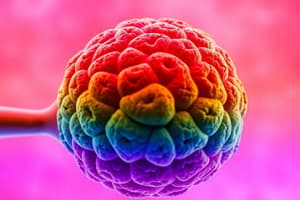Podcast
Questions and Answers
What is the most common structure affected by metastasis in the eye?
What is the most common structure affected by metastasis in the eye?
- Ciliary body
- Iris
- Choroid (correct)
- Retina
Which type of choroidal melanoma typically has pigmentation?
Which type of choroidal melanoma typically has pigmentation?
- Metastatic melanoma
- Atypical melanoma
- Primary melanoma (correct)
- Secondary melanoma
What is the mean survival time from diagnosis of metastatic orbital tumors?
What is the mean survival time from diagnosis of metastatic orbital tumors?
- Approximately one year
- Around three years
- Less than two years (correct)
- Greater than five years
Which primary systemic cancers are most commonly associated with secondary orbital tumors?
Which primary systemic cancers are most commonly associated with secondary orbital tumors?
What sign is associated with orbital metastases and involves changes in pupil reaction?
What sign is associated with orbital metastases and involves changes in pupil reaction?
What characterizes the definition of cancer?
What characterizes the definition of cancer?
Which group has the highest cancer-related death rates according to epidemiological data?
Which group has the highest cancer-related death rates according to epidemiological data?
What does the 'T' in TNM staging refer to?
What does the 'T' in TNM staging refer to?
Why have cancer death rates declined over the past 30 years?
Why have cancer death rates declined over the past 30 years?
What does 'M1' indicate in the context of TNM staging?
What does 'M1' indicate in the context of TNM staging?
Which factor is indicated as significantly influencing cancer survival rates?
Which factor is indicated as significantly influencing cancer survival rates?
What is true about the progress in cancer death rates relative to other chronic diseases?
What is true about the progress in cancer death rates relative to other chronic diseases?
What is indicated by 'N3' in TNM staging?
What is indicated by 'N3' in TNM staging?
Which blood test is specifically indicated for detecting autoimmune antibodies related to CAR?
Which blood test is specifically indicated for detecting autoimmune antibodies related to CAR?
What is a critical reason for referring patients to oncology urgently, even without a cancer diagnosis?
What is a critical reason for referring patients to oncology urgently, even without a cancer diagnosis?
Which of the following statements regarding treatment outcomes for CAR is true?
Which of the following statements regarding treatment outcomes for CAR is true?
What crucial information should be included when taking a case history from cancer patients?
What crucial information should be included when taking a case history from cancer patients?
Which characteristic is indicative of generalized dysfunction evident in the Electroretinogram (ERG) test for CAR?
Which characteristic is indicative of generalized dysfunction evident in the Electroretinogram (ERG) test for CAR?
What is the primary mechanism by which paraneoplastic diseases affect the body?
What is the primary mechanism by which paraneoplastic diseases affect the body?
Which tests are used to diagnose paraneoplastic diseases?
Which tests are used to diagnose paraneoplastic diseases?
What is a characteristic ocular effect of melanoma-associated retinopathy (MAR)?
What is a characteristic ocular effect of melanoma-associated retinopathy (MAR)?
Which of the following symptoms is typically associated with cancer-associated retinopathy (CAR)?
Which of the following symptoms is typically associated with cancer-associated retinopathy (CAR)?
In which cancers is cancer-associated retinopathy (CAR) most commonly associated?
In which cancers is cancer-associated retinopathy (CAR) most commonly associated?
What is the major symptom of nyctalopia associated with paraneoplastic diseases?
What is the major symptom of nyctalopia associated with paraneoplastic diseases?
Which of the following is a common sign of cancer-associated retinopathy during examination?
Which of the following is a common sign of cancer-associated retinopathy during examination?
What is meant by paraneoplastic optic neuropathy (PON)?
What is meant by paraneoplastic optic neuropathy (PON)?
What is a common side effect of chemotherapy that affects the gastrointestinal system?
What is a common side effect of chemotherapy that affects the gastrointestinal system?
Which of the following ocular symptoms is NOT associated with radiation retinopathy?
Which of the following ocular symptoms is NOT associated with radiation retinopathy?
Which drug class is associated with retinal toxicity?
Which drug class is associated with retinal toxicity?
What is a recommended preventative measure during radiation treatments to protect the eyes?
What is a recommended preventative measure during radiation treatments to protect the eyes?
What type of toxicity is typically associated with cisplatin?
What type of toxicity is typically associated with cisplatin?
Which of these statements is true regarding anti-VEGF injections?
Which of these statements is true regarding anti-VEGF injections?
Which chemotherapy side effect can lead to infection risk due to blood cell production inhibition?
Which chemotherapy side effect can lead to infection risk due to blood cell production inhibition?
What effect can targeted therapy have on cancer treatment?
What effect can targeted therapy have on cancer treatment?
Which of the following is NOT an ocular toxicity associated with cyclophosphamide?
Which of the following is NOT an ocular toxicity associated with cyclophosphamide?
How does hormonal therapy primarily function in cancer treatment?
How does hormonal therapy primarily function in cancer treatment?
What is a key feature of immunotherapy in cancer treatment?
What is a key feature of immunotherapy in cancer treatment?
Which method is utilized for imaging in the assessment of radiation retinopathy?
Which method is utilized for imaging in the assessment of radiation retinopathy?
Which class of drugs has been linked to side effects including uveitis in patients undergoing cancer treatment?
Which class of drugs has been linked to side effects including uveitis in patients undergoing cancer treatment?
What is the primary goal of hyper-fractionation in radiation therapy?
What is the primary goal of hyper-fractionation in radiation therapy?
Flashcards are hidden until you start studying
Study Notes
Cancer Basics
- Cancer arises from the uncontrolled division of abnormal cells that circumvent the cell cycle and apoptosis.
- Cancer has both genetic (non-modifiable) and environmental (modifiable) causes.
Cancer Epidemiology
- Cancer is the second leading cause of death in the United States.
- Cancer deaths have significantly declined in the past 30 years due to scientific progress.
- Progress in improving cancer death rates has stalled compared to other chronic diseases.
- Cancer rates are highest among men and African-Americans.
- Social determinants of health play a significant role in cancer survival rates.
TNM Staging
- The TNM staging system is used to describe the severity of cancers.
- Information is gathered from clinical exams, imaging, and/or surgery.
- T refers to the size and/or extent of the tumor.
- T0 = no primary tumor, Tis = carcinoma in situ, T1-4 = increasing tumor size and spread.
- N describes lymph node involvement.
- N0 = no regional node involvement, N1-3 = increasing number and/or extent of nodal involvement.
- M describes whether there are any distant metastases.
- M0 = no metastasis, M1 = distant metastasis.
- Scores are used to predict prognosis and dictate treatment options.
- The higher the scores, the worse the prognosis.
Radiation Therapy
- Younger patients are at a higher risk for proliferative disease from radiation therapy.
- Signs of Radiation Retinopathy: microaneurysms, hemorrhages, telangiectasias, hard exudates, macular edema, cotton-wool spots, neovascularization of the retina, iris, angle, and/or optic nerve head, vitreous heme, retinal detachment.
Radiation Retinopathy Management
- Testing
- OCT-A
- FA
- FAF
- Prevention
- Hyper-fractionation of treatment
- Using the minimal total radiation needed for effective treatment
- Eye protection during radiation treatments
- Prophylactic triamcinolone injections
- Treatment
- Anti-VEGF injections
- Sectoral or Pan-retinal laser photocoagulation
Chemotherapy
- Chemotherapy uses pharmaceuticals to arrest the reproduction of cancer cells.
- Different classes of drugs target different stages of the cell cycle.
- Various routes of administration exist.
- Chemotherapy can be used in combination with radiation or surgery.
- May be given before surgery to shrink the tumor and improve outcomes.
- Chemotherapy causes side effects including nausea, alopecia, vomiting, myelosuppression, and mucositis.
Ophthalmic Effects of Chemotherapy
- Cornea and Conjunctival Toxicity: keratitis, corneal deposits, conjunctivitis.
- Periorbital, Orbital, and Eyelid Toxicity: periorbital edema, orbital inflammation, blepharitis, ectropion/entropion, nasolacrimal duct obstruction.
- Uveitis
- Retinal Toxicity: pigmentary retinopathy, hemorrhagic retinopathy, serous retinopathy, macular edema, cotton wool spots, retinal vascular occlusion.
- Optic Nerve Toxicity: edema, inflammation, atrophy.
- Other Neuro-ophthalmic Toxicities: cranial nerve palsy, internuclear ophthalmoplegia, nystagmus, transient cortical blindness, or visual field loss.
- Other Visual Symptoms: vision loss of unclear cause, scintillating scotoma, photopsia.
Other Types of Cancer Therapy
- Targeted Therapy: Drugs that target specific genetic and molecular mechanisms of the cancer. Includes monoclonal antibodies.
- Hormonal Therapy: Used to treat hormone-driven tumors. Blocks hormone receptors. Has multiple side effects.
- Immunotherapy: Increases recognition of cancer cells by the immune system. Makes the cells more susceptible to cellular checkpoints. May be used in conjunction with radiation.
Metastasis
- The globe and orbit are uncommon sites for metastasis.
- Metastasis indicates very poor prognosis.
- Most common structures affected by metastasis is the uveal tract.
- The choroid is the most frequently affected site.
- Metastasis in the choroid can be the first indication of malignancy, even in patients with a known cancer diagnosis.
Types of Choroidal Melanomas
- Primary: Typically pigmented. Subretinal fluid may be present. Growth over months to years. Seeding uncommon.
- Secondary: Typically amelanotic (no pigmentation, yellowish). Significant subretinal fluid larger than the lesion size. Growth within weeks. Seeding is more common in the retina and vitreous.
Metastatic Orbital Tumors
- Uncommon site of metastasis.
- Comprise up to 13% of all orbital tumors.
- Most secondary orbital tumors come from breast, lung, or prostate cancers.
- Mean survival time is less than two years.
- Symptoms: pain, diplopia, and vision loss.
- Onset of symptoms is usually sudden.
- Signs include a mass upon orbital palpation, anterior segment vessel congestion, RAPD, optic nerve edema, and ophthalmoplegia.
- Diagnosis is confirmed with imaging (MRI).
Paraneoplastic Disease
- Paraneoplastic disease occurs when a malignancy triggers an autoimmune response in another part of the body.
- Patients do not necessarily have an active cancer diagnosis.
- Diagnosis is confirmed by detecting autoantibodies in the blood or cerebrospinal fluid (CSF).
Ocular Effects of Paraneoplastic Disease
- Melanoma-Associated Retinopathy (MAR): Enlargement of the ONH.
- Bilateral Diffuse Uveal Melanocytic Proliferation (BDUMP): Addressing tumors.
- Paraneoplastic Optic Neuropathy (PON):
- Other ocular effects: Cranial nerve palsies, saccadic eye movement deficits, deficits in pursuits, Cancer-associated retinopathy (CAR).
Cancer-Associated Retinopathy
- Most common ocular paraneoplastic disease.
- Diagnosis of exclusion.
- Most associated with small cell lung, breast, ovarian, endometrial, and cervical cancers.
- Autoantibodies react with the photoreceptors causing their destruction.
- Typically no signs of disease on DFE.
- Insidious onset of symptoms.
CAR Signs and Symptoms
- Symptoms (usually bilateral): Central vision loss, nyctalopia, dyschromatopsia, photopsia, and photophobia.
- Signs: Uveitis, macular edema, retinal vasculitis.
CAR Diagnosis and Management
- Testing: OCT, electroretinogram (ERG), blood testing for autoantibodies.
- Management: Systemic steroids, systemic immunomodulatory therapy, referral to an oncologist if no cancer diagnosis exists.
Clinical Pearls
- Ask detailed case history questions for cancer patients including family history, type of cancer, stage, metastasis (if any), treatments performed, and remission status.
- Carefully look for signs of metastasis and paraneoplastic disease, even in patients with a cancer diagnosis.
- Refer anyone with these conditions but no cancer diagnosis to oncology emergently.
- Be compassionate when discussing these diagnoses with patients.
Studying That Suits You
Use AI to generate personalized quizzes and flashcards to suit your learning preferences.




